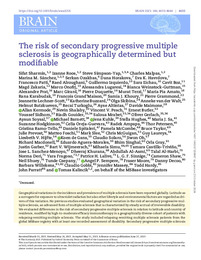Título :
The risk of secondary progressive multiple sclerosis is geographically determined but modifiable |
Autor :
Sharmin, Sifat 
Roos, Izanne
Simpson-Yap, Steve 
Malpas, Charles
Sánchez, Marina M.
Ozakbas, Serkan 
Horakova, Dana 
Kubala Havrdova, Eva 
Patti, Francesco 
Alroughani, Raed 
Izquierdo, Guillermo 
Eichau, Sara
Boz, Cavit 
Zakaria, Magd 
onofrj, marco |
Editor :
Oxford University Press |
Departamento:
Departamentos de la UMH::Medicina Clínica |
Fecha de publicación:
2023-06 |
URI :
https://hdl.handle.net/11000/33818 |
Resumen :
Geographical variations in the incidence and prevalence of multiple sclerosis have been reported globally. Latitude as a surrogate for exposure to ultraviolet radiation but also other lifestyle and environmental factors are regarded as drivers of this variation. No previous studies evaluated geographical variation in the risk of secondary progressive multiple sclerosis, an advanced form of multiple sclerosis that is characterized by steady accrual of irreversible disability. We evaluated differences in the risk of secondary progressive multiple sclerosis in relation to latitude and country of residence, modified by high-to-moderate efficacy immunotherapy in a geographically diverse cohort of patients with relapsing-remitting multiple sclerosis. The study included relapsing-remitting multiple sclerosis patients from the global MSBase registry with at least one recorded assessment of disability. Secondary progressive multiple sclerosis was identified as per clinician diagnosis. Sensitivity analyses used the operationalized definition of secondary progressive multiple sclerosis and the Swedish decision tree algorithm. A proportional hazards model was used to estimate the cumulative risk of secondary progressive multiple sclerosis by country of residence (latitude), adjusted for sex, age at disease onset, time from onset to relapsing-remitting phase, disability (Multiple Sclerosis Severity Score) and relapse activity at study inclusion, national multiple sclerosis prevalence, government health expenditure, and proportion of time treated with high-to-moderate efficacy disease-modifying therapy. Geographical variation in time from relapsing-remitting phase to secondary progressive phase of multiple sclerosis was modelled through a proportional hazards model with spatially correlated frailties.
We included 51 126 patients (72% female) from 27 countries. The median survival time from relapsing-remitting phase to secondary progressive multiple sclerosis among all patients was 39 (95% confidence interval: 37 to 43) years. Higher latitude [median hazard ratio = 1.21, 95% credible interval (1.16, 1.26)], higher national multiple sclerosis prevalence [1.07 (1.03, 1.11)], male sex [1.30 (1.22, 1.39)], older age at onset [1.35 (1.30, 1.39)], higher disability [2.40 (2.34, 2.47)] and frequent relapses [1.18 (1.15, 1.21)] at inclusion were associated with increased hazard of secondary progressive multiple sclerosis. Higher proportion of time on high-to-moderate efficacy therapy substantially reduced the hazard of secondary progressive multiple sclerosis [0.76 (0.73, 0.79)] and reduced the effect of latitude [interaction: 0.95 (0.92, 0.99)]. At the country-level, patients in Oman, Tunisia, Iran and Canada had higher risks of secondary progressive multiple sclerosis relative to the other studied regions.
Higher latitude of residence is associated with a higher probability of developing secondary progressive multiple sclerosis. High-to-moderate efficacy immunotherapy can mitigate some of this geographically co-determined risk.
|
Palabras clave/Materias:
secondary progressive multiple sclerosis
disease-modifying therapy
latitude
geography
health expenditure |
Tipo de documento :
info:eu-repo/semantics/article |
Derechos de acceso:
info:eu-repo/semantics/openAccess |
DOI :
https://doi.org/10.1093/brain/awad218 |
Publicado en:
Brain. 2023 Nov 2;146(11):4633-4644 |
Aparece en las colecciones:
Artículos Medicina Clínica
|
 La licencia se describe como: Atribución-NonComercial-NoDerivada 4.0 Internacional.
La licencia se describe como: Atribución-NonComercial-NoDerivada 4.0 Internacional.
.png)
